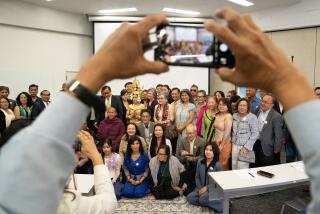Removing the Khmer Rouge With ‘Shotgun’
- Share via
Indochina is again on the front burner of American foreign policy, and no one is happy about it. This time it is Cambodia, not Vietnam, that is the center of concern. Following the failure to reach agreement at the International Conference on Cambodia in Paris, the sense of disappointment and uncertainty in Washington is tangible. But this is no time to lose sight of our objectives in Cambodia.
For nearly three decades, through coups, guerrilla war, military incursions, a genocidal blood bath, foreign invasion and occupation, Cambodia has been fought and bled over. For the past 11 years it has been under a Vietnamese military occupation resisted by an uneasy coalition of non-communist and Khmer Rouge guerrillas.
However, Vietnam has finally brought an end to its military presence. In anticipation of the withdrawal, 18 nations and four Cambodian factions convened in Paris in an attempt to negotiate a comprehensive political settlement. The Cambodian participants included the Vietnamese-installed Cambodian government of Hun Sen, the fanatical Khmer Rouge and the two non-communist resistance groups, including one led by the same man who ruled Cambodia before all the trouble started--Prince Norodom Sihanouk.
The obstacles to a settlement were obvious from the outset--particularly the terrible dilemma posed by the Khmer Rouge. Pol Pot’s corps of killers is perhaps more loathed than any other political movement in the world for its systematic extermination of more than 1 million Cambodians, perhaps one-fourth of the entire civilian population of the country. But the Khmer Rouge is also arguably the strongest military faction in Cambodia and enjoys solid political and logistical support from China.
A crescendo of voices in the West has demanded that the non-communists sever all ties with the Khmer Rouge. But Sihanouk has not dared to do so because China is his major source of weapons, and Beijing insists that the Khmer Rouge be accorded a role in a settlement. Besides, the Khmer Rouge are dangerous enemies, and if Sihanouk turns against them, he will need strong and credible support from the West.
On the eve of the Paris talks, the Senate almost unanimously declared that it would consider substantial assistance to a new Cambodian government, but only if it included non-communist participation and strict limits on the role of the Khmer Rouge. Congress also voted to authorize the Administration to propose a program of lethal assistance to the non-communists in order to strengthen their political and military position. These votes are benchmarks in the process of finally putting the Vietnam War to rest and fashioning a new American foreign policy toward Southeast Asia.
The Paris talks reached an impasse. The Hun Sen regime in Phnom Penh and its Vietnamese ally were not prepared to share authority in any meaningful way with anyone else. Various power-sharing formulas were proposed, all of which preserved the existing government structure intact. Nevertheless, Hun Sen and the Vietnamese rejected them outright.
The outcome in Paris has not changed U.S. interests. What we sought before Paris, and seek now, is an independent, democratic, non-communist, nonaligned government that can live at peace with its neighbors and its own people. The non-communists are still the one group clearly committed to this objective. Sihanouk is still the only political figure on the Cambodian scene capable of uniting the country and establishing Cambodia’s legitimacy in the broader international community.
I believe there is a way out of the Cambodian maze. It requires a shotgun marriage between Hun Sen and Sihanouk. Specifically, we must overcome Sihanouk’s fear of divorcing the Khmer Rouge and Hun Sen’s resistance to sharing power with the non-communists. The United States and its partners in the Assn. of South East Asian Nations should make it clear to Sihanouk that he must break with the Khmer Rouge and strike a separate deal with Hun Sen. To strengthen his hand, ASEAN and the United States should provide the materiel, both lethal and nonlethal, that the non-communists may require to survive the military test of strength that is already beginning with the advent of the dry season in Southeast Asia.
Even more important, the United States should orchestrate with Japan, the European Community and the international lending institutions an unmistakable message to Hun Sen. That message should be blunt: The industrialized democracies stand ready to provide vital economic assistance to a new Cambodian government if, and only if, that government is democratically responsive to the will of the Cambodian people and includes significant participation by the non-communists. Together, the government and the non-communist resistance can establish a viable government in Phnom Penh with the political credibility, the military strength and the international support to cope with the Khmer Rouge. In short, they can bring Cambodia’s long nightmare to an end.
More to Read
Sign up for Essential California
The most important California stories and recommendations in your inbox every morning.
You may occasionally receive promotional content from the Los Angeles Times.













